Thank you for your readership.
Grant money will lay roots for tree planting in South L.A.
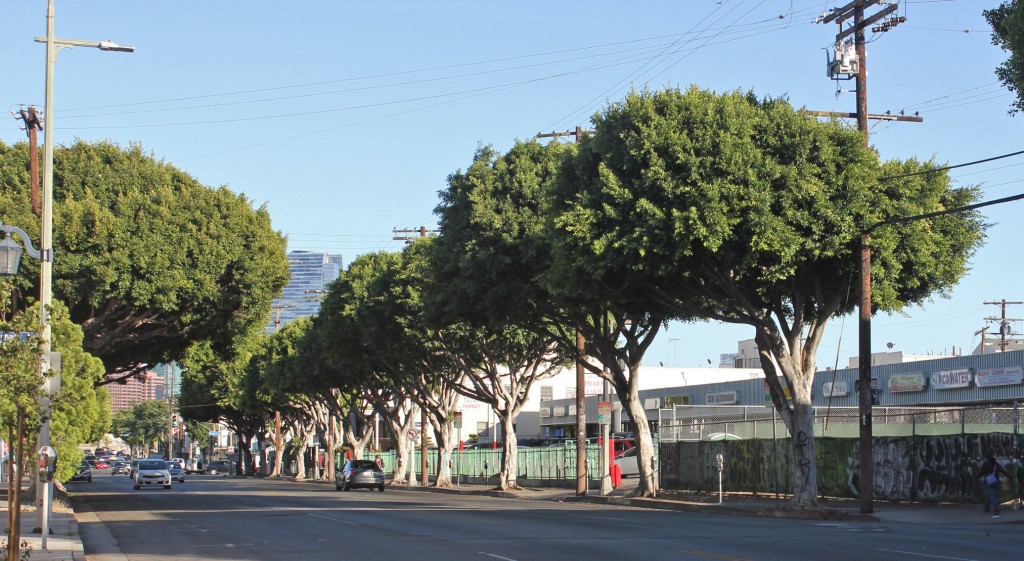
The goal of the grant KYCC received is to ensure half of the possible tree sites in South Los Angeles and Pico-Union are planted, creating consistent shade coverage. | Rachel Cohrs, Intersections South L.A.
One community organization has a grant to plant trees in South Los Angeles, but first it has to convince local residents that picturesque, tree-lined streets aren’t just for neighborhoods in Beverly Hills.
“If you’re struggling on a daily basis, trees might not be the first things you’re thinking about. These communities deal with crime, a large homeless population, illegally dumped trash, graffiti, and gang violence … Most people are just trying to get by,” said Ryan Allen, Environmental Services Manager of Koreatown Youth and Community Center (KYCC).
However, Allen and the staff at KYCC know that planting trees can have positive effects in low-income communities. The benefits of having densely planted trees include reduction of energy costs, creation of shade, and the beautification of neighborhoods.
In neighborhoods like South Los Angeles and Pico-Union, which both scored poorly in air quality evaluations, planting trees can help reduce the effects of pollution by removing toxins from the air.
“One tree on its own will do those things, but there is the idea of strength in numbers,” Allen said.
KYCC received nearly $330,000 in grant money from the California Department of Forestry and Fire Protection to make the vision of dense tree cover a reality in the South Los Angeles and Pico-Union areas.
The funds stem from a cap-and-trade program passed in California in 2006 to reduce greenhouse gas emissions. Under cap-and-trade, companies have to pay for emissions over a certain limit, increasing the incentive to reduce air pollution. At least 25 percent of the revenue from the program is distributed to greenhouse gas emissions-reducing projects in low-income neighborhoods.
South Los Angeles struggles with high levels of pollution that are compounded by other problems. A case study of the area shows that the South Los Angeles area is “disproportionately burdened” by poverty, unemployment and linguistic isolation.
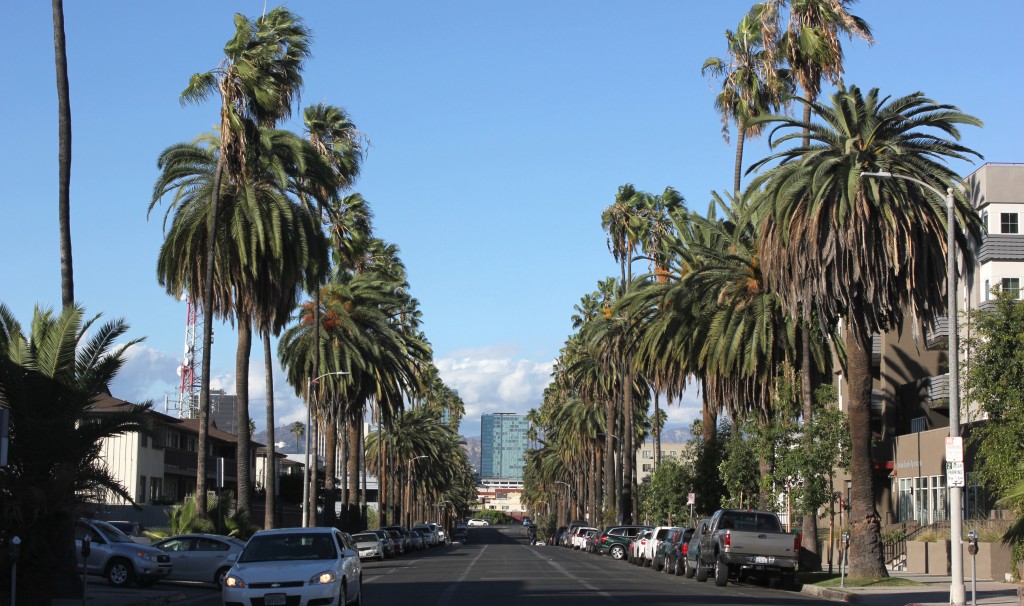
KYCC helped plant small trees between other trees to create shade cover on this street in South Los Angeles. | Rachel Cohrs, Intersections South L.A.
KYCC got the grant to plant 1,120 trees over a four-year period starting in 2016. Its goal in the project is to use the grant to see that at least half of the potential tree sites on neighborhood streets planted.
After the initial planting, KYCC will provide funding to maintain the trees for the first three years. After that, the trees will have grown substantially and will need less maintenance work. Despite the benefits of having trees planted, not everyone is on board with the plan.
Community members have voiced concerns about tree roots breaking up sidewalks, having to water, prune and maintain the trees, and the trees dropping leaves. Allen also cited a mental barrier that trees might not fit the culture of South Los Angeles neighborhoods. In the past, trees planted incorrectly caused sidewalks to crack and fall into disrepair.
That’s what the KYCC grant is for. Beyond buying trees to plant, the organization plans to reduce barriers and address community concerns. If community members voice worries, then KYCC can use some of the grant money to remove stumps or invasive trees, repair sidewalks, check sewer lines, and other incentives.
“We are going to try to address different concerns people could have so they don’t have reason to say no,” Allen said.
KYCC is qualified to mitigate these potential issues because the organization has been involved in tree planting efforts since 1999, and has expertise in selecting the right tree species and planting them in the right places to ensure they won’t damage sidewalks.
The task of physically getting the trees planted is expected to be an undertaking that will require community engagement. Previously, KYCC has gone door to door knocking and asking if residents would like a tree. The new grant is based on individuals taking responsibilities for their own streets and talking with their neighbors to get trees planted.
KYCC also plans to help organize community planting events to help get residents’ hands dirty and encourage involvement with the cause.
“It takes somebody dedicated, and a certain amount of legwork to work with neighborhood and to get people interested,” Allen said.
KYCC will be working through community organizations to streamline the process. Allen said the team is just now beginning to work with other organizations from existing partnerships and make new connections.
One new organization KYCC could be partnering with for a tree planting project on a different grant is the Redeemer Community Partnership.
Redeemer has an independent initiative focused on Jefferson Boulevard to “Make Jefferson Beautiful” by beginning a tree canopy, repairing sidewalks, and integrating bike lanes for safer transportation. Niki Wong, the lead community organizer at Redeemer Community Partnership, said she wants all the area surrounding USC to benefit from the university investment.
Tree cover on Jefferson on the USC side versus the community side
“USC is right next door. Vermont Avenue kind of serves as this invisible line between two cities….Part of what we are hoping to do is kind of dissolve that line and make the closeness beneficial for folks in the neighborhood,” Wong said.
Wong said one of the most important benefits of partnering with KYCC on a tree planting project is the commitment to long-term maintenance and community engagement. The grant Wong applied for through the Los Angeles Neighborhood Initiative would maintain 15 trees, plant 14 new trees, and replace two dead trees. Although the shade will not be provided immediately, within a few years well-tended trees will provide the full benefits.
Besides the environmental advantages of having trees planted, Wong also said attractive tree cover could encourage residents to go outside more and help draw businesses to the area.
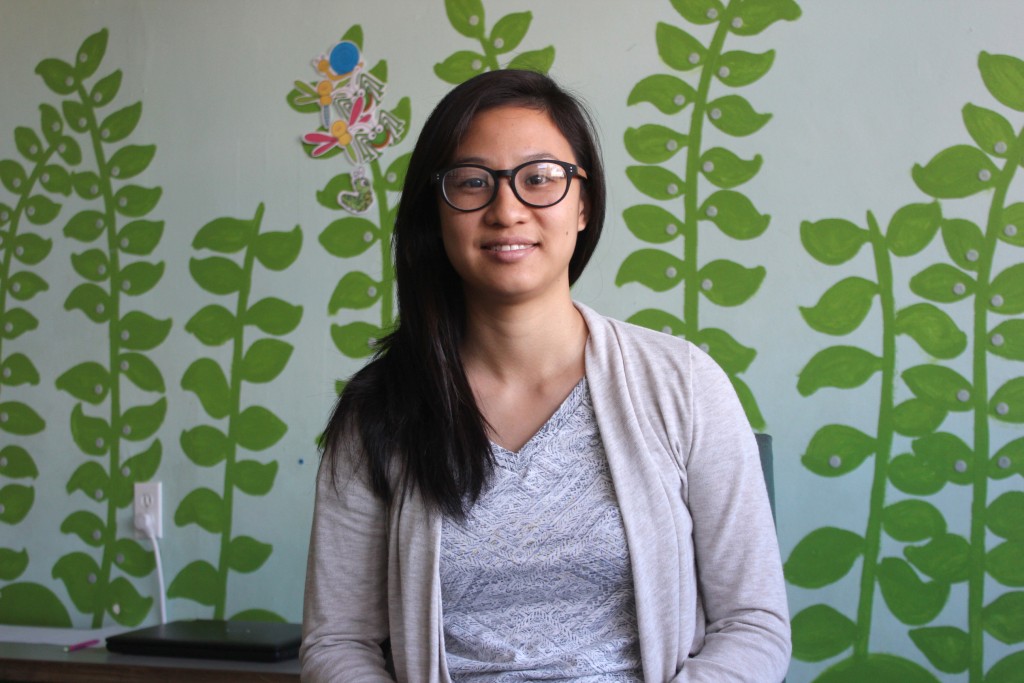
Niki Wong works with Redeemer Community Partnership to get grants to make Jefferson Boulevard safer and more beautiful. | Rachel Cohrs, Intersections South L.A.
Further, Wong pointed out that even though grant money is being set aside to help remedy these problems, under-resourced communities may not have the time or expertise to complete complicated grant application processes.
“This is for a community that has been overlooked, and at the bottom of the priority list for all sorts of improvements. Our crosswalks are faded, our sidewalks are broken, and a lot of tree wells are empty or have dead trees in them. It’s just very clear that there has been neglect,” Wong said.
Applications for annual grants will be available for the KYCC grant funds in the spring. Community organizations can apply and individuals can also get support to build up a tree canopy in South Los Angeles. Both Wong and Allen emphasized that in order to move forward with the projects, community support and engagement is essential.
“We want to be helping communities and residents to make their vision for a better neighborhood happen,” Allen said.
South LA youth, non-profits sue city over neighborhood oil drilling
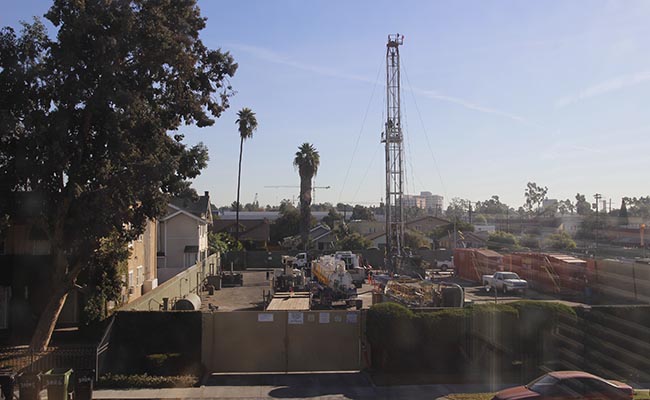
At its closest point, the Jefferson drill site is only three feet from homes. | Caitlyn Hynes, Intersections South L.A.
A few blocks west of the University of Southern California, behind ivy-covered walls, is the Jefferson oil-drilling site. The walls may block neighbors from seeing what goes on behind them, but they know, nonetheless.
Now, South Los Angeles youth, tired of living near toxic chemicals with little protection, are joining together with environmental non-profits to sue the city.
The Jefferson drilling site, owned and operated by Freeport-McMoran Inc., is one of the sites named in a lawsuit brought against the city. Located in the heart of a South Los Angeles neighborhood, the site is protected only by a retaining wall that neighbors say does little to contain the noise and odors produced by drilling. Other South L.A. sites face similar problems.
The plaintiffs in the lawsuit, the South Central Youth Leadership Coalition, Communities for a Better Environment, and the Center for Biological Diversity, held a press conference last Friday to announce the case. The groups allege that the city has not only violated regulations from the California Environmental Quality Act by issuing exemptions for environmental impact reports on oil drilling and production sites, but that it has also forced residents of color to bear disproportionate environmental and health burdens because of the lack of safety measures around several South Los Angeles sites.
Standing outside City Hall Friday with signs with that read, “Our health is not for sale” and, “Ain’t no power like the power of youth,” the minors stood behind speakers who demanded that the city comply with the California Environmental Quality Act by conducting environmental impact reports and providing better protection from, odors, toxins and noise pollution at the drilling sites.
“Our health and our environment are at risk. Community members should not have to jeopardize their health by simply being at home,” high school student Joshua Navarro told the press.
The lawsuit comes on the heels of an October audit that found that since 2007, most Los Angeles oil sites have not been subjected to an environmental impact report assessing the site’s health and environmental impacts on surrounding communities.
Reports from Al-Jazeera America found that the Jefferson drilling location is one of the sites lacking such documentation. It is currently unclear why these oversights have continued.
Protests and this lawsuit against oil companies have drawn the support of youth who live in the neighborhoods surrounding the Jefferson drill site. Many of the kids involved have lived around the site for years. They’ve smelled the chemicals and heard the loud sounds that often accompany drilling.
Elena Hume, 10, has been involved with several protests. She said she and her family would smell the chemicals as they went on walks around their neighborhood.
“I never knew it was an oil-drilling site. We’d see the bushes, and the rows of trees, and the big yellow gate,” Hume said. But now she knows what is happening and she feels it’s wrong to expose her neighborhood to the fumes of the toxic chemicals.
Jordan Parks, 12, has lived near the site his entire life. For a long time he and his family didn’t know exactly what was behind the walls. But when his father discovered it was an oil-drilling site, “Everyone started realizing how incredibly bad it was,” Jordan said.
Youth from the neighborhood around the Jefferson site, brought together by school, church and neighborhood tutoring programs, have become more involved in the issue through protests at the drilling site over the past few years.
Richard Parks, Jordan’s father, said that the kids were the ones who wanted to take action. He said the youth wanted to initiate the process because their homes and families were being directly affected.
A report from the National Resources Defense Council found that the chemicals used at oil drilling sites have been linked to cancer and other reproductive health problems. Neighbors have also blamed the site for headaches, nosebleeds and asthma.
Tanja Srebotnjak, a professor at Harvey Mudd College who has worked in oil and gas research for over fifteen years, said that the closer neighbors are to the chemicals used at oil drilling sites, the more susceptible they are to health complications.
“Farther is better and some states and municipalities have set distances ranging…up to 1,500 feet, 2,000 feet,” Srebotnjak said.
But a 2014 Community Health Councils study found that South L.A. drilling sites located in neighborhoods with high percentages of people of color were significantly closer to homes, schools and churches than sites in West L.A.
While the average distance from homes, schools and churches in South L.A. is 85 feet, the West L.A. and Wilshire sites, located in primarily white neighborhoods, are about 400 feet away.
Many West L.A. sites also have enclosed structures or some type of geographic barrier like a golf course that can help mitigate noise and odors. The Jefferson site, in contrast, has only a retaining wall as physical protection.
Niki Wong of Redeemer Community Partnership, a South L.A. non-profit that works in the neighborhood around the Jefferson drill site, estimated that the wells at the site are a mere 60 feet from homes, a distance that almost certainly exposes residents to toxins. Without an environmental impact report, it is hard to know exactly how the community would be affected if an explosion or other accident were to happen on the site.
Wong said that it is key to involve the youth of the neighborhood in this effort. “It’s important for them [to recognize] the need for a healthy and safe environment to grow up in.”
As for the kids around the Jefferson drill site, they say they just want their neighborhood to be safe for families. “It’d be nice if they just shut [the drilling site] down and turned it into a park or something, or more housing,” said Jordan.
The city attorney’s office told the Los Angeles Times that it will review the lawsuit.
Manipulating the magnets
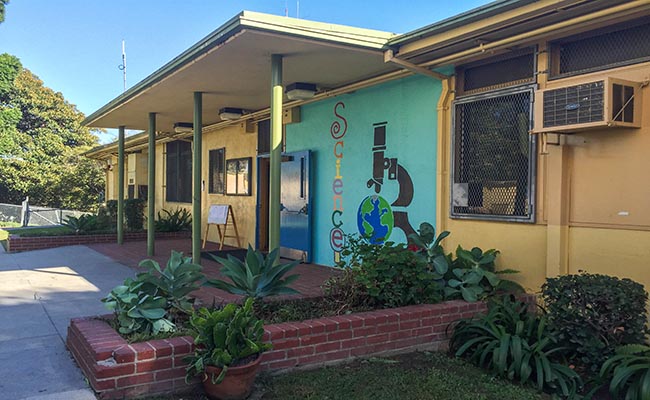
Mid-City’s Prescott School of Enriched Sciences is the only school that feeds directly into the Los Angeles Center for Enriched Studies. LACES is one of the top schools in the state. | Caitlyn Hynes, Intersections South L.A.
Four weeks into the school year, Ellen Hume got the call she had hoped wouldn’t come. Her daughter Elena, 10, had been taken off the waitlist and accepted into Mid-City’s Prescott School of Enriched Sciences.
Like many parents in the Los Angeles area, Hume had been applying for magnet schools since her daughter was in second grade. When Hume received the call, she was happy with Elena’s then-current elementary school, Synergy Charter Academy, and didn’t necessarily want her child to go to Mid-City.
Yet, for Hume and many other parents, the appeal of Mid-City is not Mid-City itself, but the fact that it is the only direct feeder school for the Los Angeles Center for Enriched Studies.
LACES, as it is better known, is the highest ranked school within the Los Angeles Unified School District according to U.S. News and World Report. In 2015, the school had 3,247 applications for 224 open spots. That admission rate is less than 7 percent—more selective than UCLA that same year.
To ensure a child’s admission into LACES, some parents have decided to apply to Mid-City in their child’s later elementary school years. Their year at Mid-City is simply a means to an end, something 10-year-old Elena herself is aware of.
“I think it will be worth it to switch from Synergy to Mid-City to get into LACES. If I had a choice I would choose Synergy and LACES but I know that’s kind of impossible,” she said.
Phil Placenti, who must weigh the educational future of his two daughters, said the reliability and success of LACES are what has drawn their family to the school.
“It has an established school culture that is healthy, it offers a wide range of classes and clubs, and impressive numbers of LACES students go to good colleges,” Placenti said. “LACES isn’t perfect, but it is consistently strong, and has been for a long time.”
LACES also offers sixth through 12th grade, meaning if a child gets in as a sixth grader, the parents no longer have to play the magnet points game.
The fact that Mid-City offers families the chance to matriculate directly into LACES, a solid, steady and reliable school, means that parents whose children have been offered admission into Mid-City have to carefully weigh their options.
If they accept, children may be attending a lower-performing school in a far-away neighborhood. If they decline, they will lose all of their magnet points – a disaster for upper-elementary school students preparing for the middle school magnet application process.
“It’s the only system where you’re applying, and find yourself hoping you don’t get accepted,” said Jolene Hjerleid, whose daughter was accepted to Mid-City in 2012 and is now an eighth grader at LACES.
Hume eventually decided to send Elena to Mid-City. because doing so would set her up for the next six years of her academic career.
Read More: Los Angeles magnet school shows off successful STEM and AP program
“Even though we loved Synergy, Mid-City is a feeder school for LACES,” said Hume. “We decided to send her to Mid-City for one year because she would be set up for the rest of junior high and high school.”
Amy Levinson also saw Mid-City as merely a stepping stone to LACES. When her son was accepted into the elementary school the day before starting fifth grade, she decided to take the spot to guarantee his place at LACES.
“We agreed within the day that we were going to do it because it would solve the middle school and high school problem. So it was worth it for him to have upheaval for a year. But he was leaving his school again, where he was thriving,” Levinson said.
The magnet points system and lack of streamlined school experience in LAUSD means that parents are constantly thinking ahead and planning for the future.
“I don’t know how often I’m in conversations with people at parties or whatever and we’re always asking about, ‘Where does your kid go to school? How’d they get there? What are you going to do next year?,” Hjerleid said. “There’s not a logical place for the kids to feed into next year.”
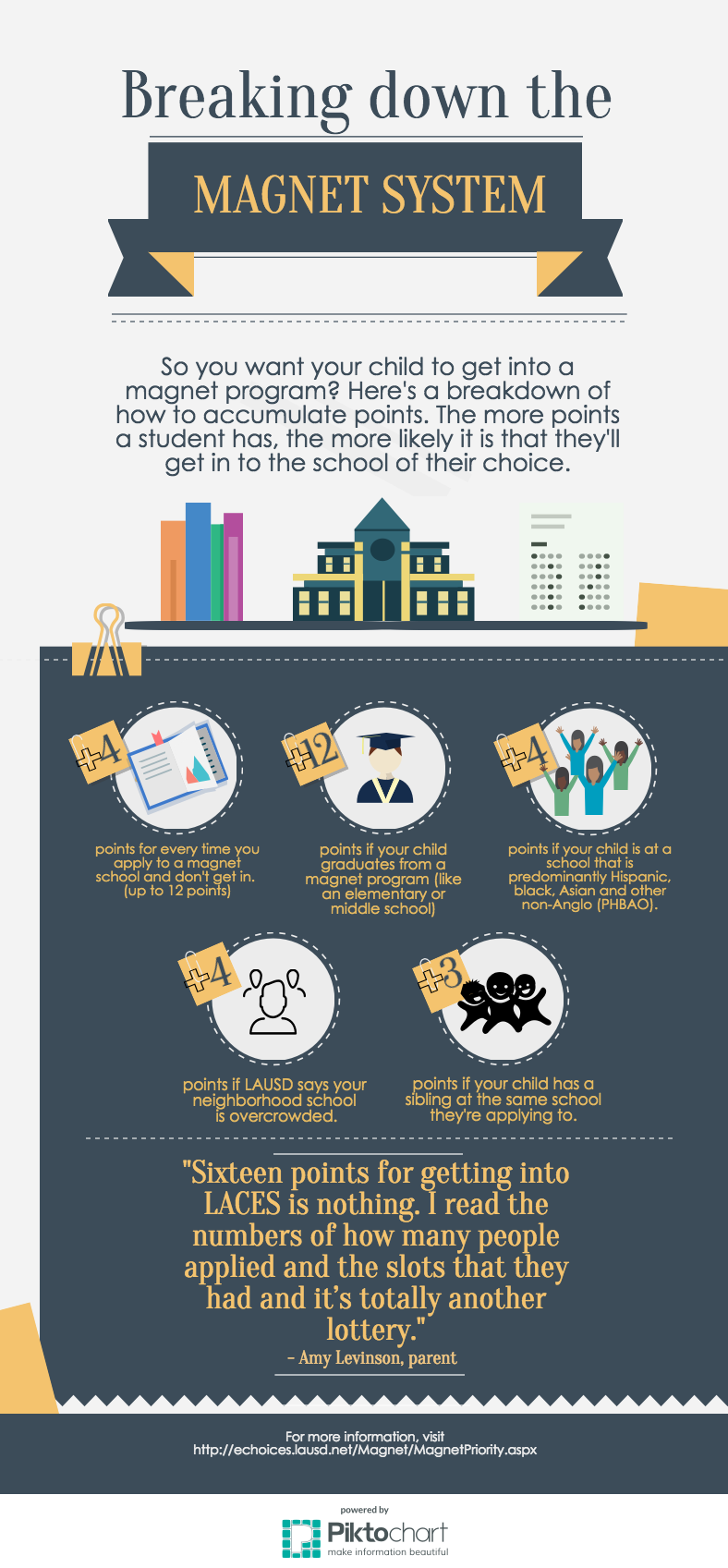 The stakes for magnet points got higher in 2011 when LACES officials made Mid-City their only feeder school. The decision meant that parents didn’t have to rely solely on one application year, but could automatically matriculate to LACES if they went to Mid-City. Students are also significantly more likely to get into Mid-City. Last year they had 189 applications for 61 spots, and a 32 percent acceptance rate—more than four times as high as LACES
The stakes for magnet points got higher in 2011 when LACES officials made Mid-City their only feeder school. The decision meant that parents didn’t have to rely solely on one application year, but could automatically matriculate to LACES if they went to Mid-City. Students are also significantly more likely to get into Mid-City. Last year they had 189 applications for 61 spots, and a 32 percent acceptance rate—more than four times as high as LACES
Hjerleid‘s daughter was in one of the first classes at Mid-City to be directly admitted to LACES. When the change was announced, she says there was some backlash among parents.
“Everyone was a little surprised when Mid-City was chosen as a feeder school. I think people were like, why is this little unknown elementary school being chosen for the magnet?” she said.
LAUSD was unavailable for comment on why Mid-City was chosen as the sole feeder school for this article.
Though Mid-City has consistently improved its API score over the past five years, rising from 761 in 2008 to 801 in 2013, only 51.9 percent of students were at or above proficient in English, and 57.2 percent in math, according to its 2013 Adequate Yearly Progress report.
In contrast, Synergy Charter Academy, where Hume’s daughter Elena attended from kindergarten to fourth grade, had an API of 907 with 75 percent of students proficient in English and 88.9 percent in math.
When Hjerleid and her husband decided to transfer their daughter to Mid-City in 2012, they left West Hollywood Elementary School, which had a 932 API score that year and an 83.5 percent proficiency in English and 85 percent proficiency rate in math.
The qualitative aspects such as Mid-City’s disorganization and lack of academic rigor, however, are what the parents interviewed focused on.
Levinson, whose son also spent a few years at West Hollywood, was disappointed with Mid-City’s academic standards.
“It felt like he was taking a huge step back academically. The math was not hard for him. He didn’t have vocabulary all year,” said Levinson. “Just things that felt like they were a given; like vocabulary and spelling tests. I felt like his preparation [for LACES] came at West Hollywood.”
Hjerleid and her husband also wondered if it would be worth it to transfer to Mid-City. The academic expectations, she said, were not as high as she believed were necessary. “And that was disappointing, but we were prepared for it,” she said.
Hjerleid and Hume both confirmed that they accepted their spot at Mid-City not because they felt it would be academically challenging for their children, but because they knew if they did not accept, they risked losing their chance at LACES permanently.
Read More: Crenshaw High’s magnet conversion and Baldwin Hills families
Placentis’ oldest daughter Analisa is a sixth grader at LACES, despite the fact that she didn’t get into Mid-City last year. When Analisa was put on Mid-City’s waiting list, he said it was a relief. But she was admitted into LACES this year with 16 magnet points, which is generally agreed to be the minimum number of points for LACES.
Nevertheless, the Placentis understood how hard the decision would be.
“Going to a school like Mid-City for a year or two in order to know that your child will have a solid middle school option can be a difficult thing to pass up. For our older daughter, we applied for a spot at Mid-City and prayed she wouldn’t get it,” said Placenti.
Hjerleid says they wouldn’t have changed anything regarding the decision they made for their daughter’s education.
“We also thought our daughter was the kind of student and personality that could weather that pretty well and maintain a sense of academic rigor and studying and all of that even if the expectations were lower than where she had come from,” said Hjerleid.
Despite the different academic expectations, some parents believe that one-year at Mid-City will be regained in value many times over while attending LACES.
Hjerleid summed it up: “Now we’re done, basically. . . it feels great to know that they’re both there at LACES, sixth through 12th grade. Now we just need to worry about college applications in three or four years.”
South Central development project concerns neighbors
A new South Los Angeles development project drew sharp criticism from neighbors and health advocacy groups at a press conference Monday. A report released by Human Impact Partners found that “The Reef” development, slated to build two multi-use high-rise buildings, will place over half of renters in the site’s surrounding area at high risk for financial strain or displacement.
In September, the City Council released a 3,000 page environmental report on the development. The document has been has been a source of strain on attempting to be involved in the development process.
“In the immediate, we are concerned about the draft [environmental impact review] project that has only given us 47 days to respond to a 3,000 page document,” said Benjamin Torres of CDTech.
Beyond the environmental impact report, the community is concerned that the development will bring new residents into the proposed luxury apartments while pushing out lower-income locals because of rising rent and property value.
Read More: Neighborhood council to take action on Reef Project report
Los Angeles is the least affordable city for renters, and HIP found that the city lost 65 percent of state and federal funding for affordable housing between 2009 and 2014.
The South Los Angeles neighborhood surrounding the development is one of the most crowded areas in the city. In the community where 45 percent of residents fall below the poverty line, a rise in prices leaves many residents forced to compromise.

Residents hold a press conference in front of The Reef, which plans to develop two new skyscrapers in South LA over the next 15 years. | Caitlyn Hynes, Intersections South L.A.
Community members are worried that The Reef development will not include affordable housing, an issue that already exists. At the press conference, residents and community leaders urged developers and the City Council to consider their voices throughout the 15-year building process.
Benjamin Torres of CDTech said he was concerned that the decisions made about the development would not include the input of the neighbors who currently live there.
“One [concern] is the long-term process and what the role of the community is, and making sure we have equitable community development that benefits the area,” he said.
Neighbors want South L.A. to attract developers. They also want development to reflect the neighborhood’s residents as they are now, not those who will move in to be a part of The Reef’s demographic.
“Let’s imagine for one minute what this project could be. Imagine if this was affordable housing for the residents of affordable housing for South Los Angeles,” said Jim Mangia, President and CEO of St. John’s Well Child and Family Center. “Imagine if that development was serving the people of this community, who have built this community with their blood and their sweat and their tears. Imagine if some of that retail space were community health centers that served this community.”
Read More: Some South LA residents express uncertainty with billion dollar development
Dr. Holly Avey of HIP said that her organization was concerned about the negative impact that this development could have on the historic South Central L.A. neighborhood. The report found that community residents who are impacted by displacement and financial issues are at a high risk of a variety of health problems, including anxiety, depression, obesity and diabetes.
Beatriz Solis of the California Endowment said that some families are forced to make delicate tradeoffs, like choosing between healthy food or preschool.
Cynthia Bryant, the owner of a local ice cream shop, voiced her concern that when the development does go forward, the businesses in The Reef will push her out of the neighborhood. Bryant worries that the business space in The Reef will drive up rent prices across the neighborhood.
“I don’t want to be the first one to get on the boat if we get pushed out of this community, because they’re pushing us further and further. But where is the boat loading? Should I be the first or should I be the last, should I keep hanging on?” said Bryant.
The rising rents and subsequent displacement of residents worries Solis as well.
“At the community level, when people are forced out, the whole community fabric begins to unravel, and what cohesion and collaborative efficacy, or social and political power did exist begins to evaporate, making it more and more difficult to have a voice in community development,” Solis said.
Neighbors like Erendira Morales, a working mother of four children, say they want to be a part of this process to make sure that their concerns are being heard and addressed.
“We feel that they are playing with the life and the future of the people who live in this community. Our local representatives are not listening to us,” said Morales. “We have our interests, we have our opinions and we feel that they are not paying attention to us. We want to participate, we want to be part of this process.”
South L.A. Structures on Shaky Foundations
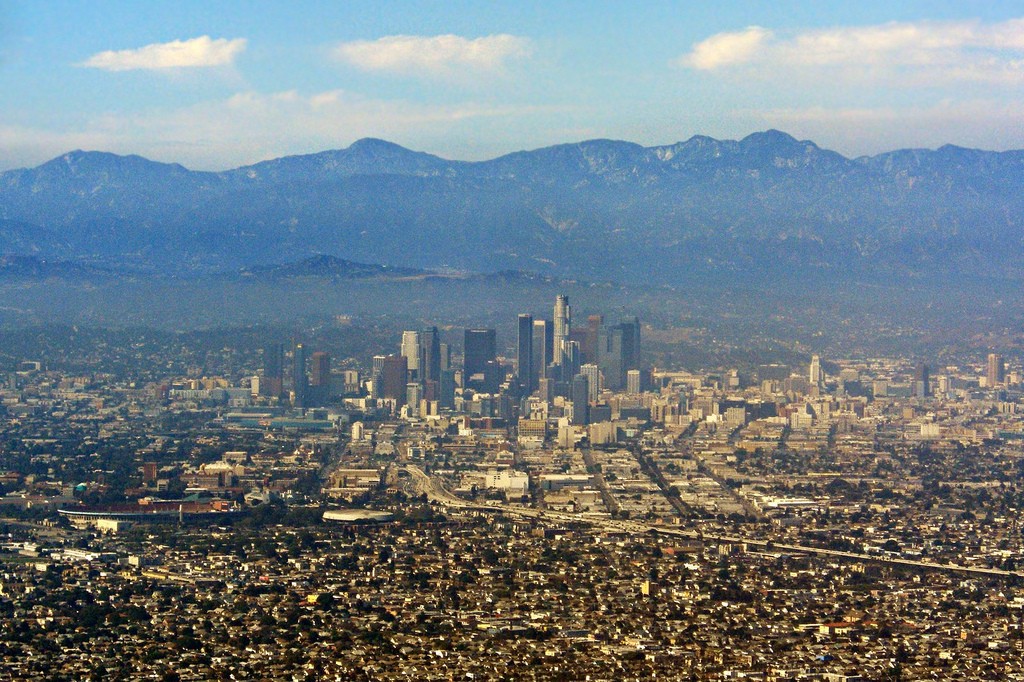
Experts say thousands of Los Angeles homes will collapse in a large earthquake.| Cameron23, Flickr Creative Commons
Imagine the Los Angeles skyline in its entirety. Include the apartment and commercial buildings; the houses old and new. Now, imagine 50 percent of those buildings gone—collapsed either partially or completely.
That is the bleak picture that U.S. Geological Survey seismologist Dr. Lucy Jones painted for attendees during the 2015 Great California ShakeOut Breakfast Leadership Summit on Sept. 30.
Los Angeles has not experienced a major earthquake in 20 years. The last large temblor to slam the region was the 1994 Northridge earthquake. Since then, California faults have been in a quiet period that Jones and other experts on her team insist won’t last.
The period of smooth sailing has caused home and commercial building owners to relax their approach to protecting structures against the damage they could sustain in the violent shaking during a substantial quake.
Lack of action to strengthen structures, however, renders the millions of people who live and work in the city’s 300,000 unstable buildings susceptible to displacement from work or homes, and even disaster-related death.
Residents push to clean up illegal trash dumpings

Active Recycling has taken more than 200,000 pounds of illegally dumped trash off LA streets . | Photo by Rachel Cohrs
Active Recycling, a private recycling company on West Slauson Avenue, is offering free trash drop-offs for up to 2,000 pounds on the first trip. Normally, a similar drop-off could cost around $100. Active Recycling then sorts out the recyclable goods.
“Everyone thinks I’m crazy for doing it. It’s costing me a lot of money. What I’m getting out of it is a cleaner city for my children, my grandchildren, and for other people’s children,” Errol Segal, who takes care of day-to-day operations as a senior consultant for Active Recycling, said.
In the first two weeks of the program, 220,000 pounds of illegally dumped trash were taken to Active Recycling. Drop-offs, however, have slowed down in the recent weeks.
While the program was originally intended to last from Aug. 28 to Oct. 15, Segal has decided to extend the offer indefinitely as long as people continue dropping off trash.
“I’m not going to stop for as long as it takes to clean up the city,” Segal said.
Illegal trash dumping has been a nuisance in Los Angeles in recent years, many said. Residents from all over the city take truck-loads of trash to South Central alleys that have become dumping grounds.
Local resident Charletta Butler said near her home, illegally dumped trash has piled up for months. She described rusted cars without wheels and abandoned refrigerators that are languishing in a nearby alley. While she said residents put in a service request more than a month ago, the mess still has not been cleaned up.
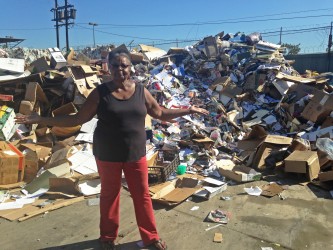
Resident Charletta Butler poses with community trash that has been brought to Active Recycling. | Photo by Rachel Cohrs
“If someone came from out of state came to visit, they would go away saying this is primitive. This is third world living,” Butler said.
The illegal dumping also causes safety concerns because emergency response vehicles can’t navigate alleys filled with truck loads of trash.
After a City Administrative Office report released in March found that Los Angeles lags behind other cities in trash can availability and street cleanliness, Mayor Eric Garcetti signed an executive order to add 5,000 trash cans, add a third “strike team” to respond to illegal dumping requests and to create a cleanliness index to measure progress.
Segal doesn’t think adding more trash cans will solve the problem, since much of the refuse is too large to fit in them.
“What people are dumping illegally on our streets and alleys and sidewalks in vacant lots and by the highways is not a trash can full. If that were all it was it wouldn’t be much of a problem,” Segal said.
In mid-August, city officials came under fire again after Los Angeles Bureau of Sanitation statistics showed that the city responded at a significantly lower rate to clean up requests in low-income neighborhoods. The L.A. Times reported that while the city responded to 99 percent of requests for trash clean-ups in some areas of the city, more than one-third of requests in dozens of neighborhoods in Central, Northeast and South L.A. were ignored.
However, the L.A. Times also reported that the percentage of requests that are not responded to overall has decreased since Garcetti took office, from 27 percent in the previous two and a half years to 15 percent.
Active Recycling hosted five press conferences about their free drop-off program. While local media outlets did attend, no city officials or representatives were present, which frustrated some local residents.
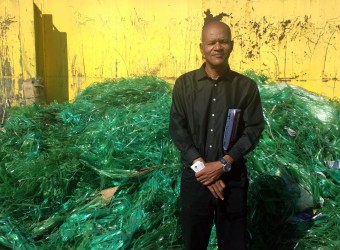
Leonard Delpit along with the Empowerment Congress Central Area Neighborhood Development Council is educating people on illegal dumping in South LA. | Photo by Rachel Cohrs
Empowerment Congress Central Area Neighborhood Development Council member Leonard Delpit said people should be educated that these opportunities exist, and recognition by city officials is a key part of getting public attention.
“Our mayor mentioned that he wants a clean street initiative. We haven’t seen the mayor, but we support the idea. The concept is correct,” Delpit said.
Segal did receive an email from Greg Good, the Director of Operations and Executive Officer for City Services stating that “The Mayor -— and all of us — greatly appreciate and support [Segal’s] efforts.”
A request for comment from the mayor’s office by Intersections was not returned.
Delpit said further options he would like to see the city pursue are more low-cost drop off opportunities at city-owned yards and camera surveillance of alleys to enforce dumping ordinances.
No matter what options are pursued, Butler said South Los Angeles residents need the problem addressed now.
“We need answers. We need to have it done, and have it done immediately. We don’t need a clean-up when our elected officials want to bring in the Olympics in 2024. We need it now,” Butler said.
Grant allocates $25,000 to promote child nutrition
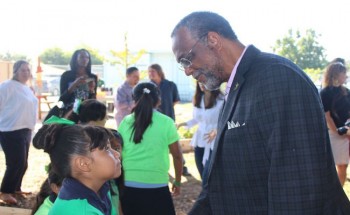
Council member Curren Price speaks with a student at West Vernon Elementary School, which is launching a grant bid. | Photo by Matt Lemas
West Vernon Elementary School in South Los Angeles is vying to be a recipient of a $500,000 national grant program to fund improvements in children’s health and nutrition. The initiative was launched at the school this week.
The initiative, a collaboration between the United Health Foundation and Whole Kids Foundation, has earmarked $25,000 for the Central and South Central region of Los Angeles.
Elementary schools throughout the country will be able to apply for funding, ranging from $15,000 to $25,000, and the application consists of pitching innovative projects in line with the grant’s goals. West Vernon is an applicant and if chosen, it will be one of 10 to 12 schools participating in the program nationwide.
“We’re breaking through the cycle of unhealthy living,” said Councilman Curren Price at Thursday’s launch, referencing that the grant could join a long list of initiatives his office has taken to improve access to nutrition and green space in his district. “When our kids are happy and healthy, our future is bright.”
Some South LA residents express uncertainty with billion dollar development
South LA residents are weighing the benefits of a proposed $1.2 billion development that promises to add condos, a hotel, a grocery store and hundreds of permanent jobs to the community.
About 60 community members came to the South Central Neighborhood Council’s town hall meeting to voice their opinion on The Reef Project. The project is an expansion around the current Reef building, which serves as a space for small creative businesses. Parking lots cover the rest of the two-block area bordered by Hill Street, Washington Boulevard, Main Street and 21st Street.
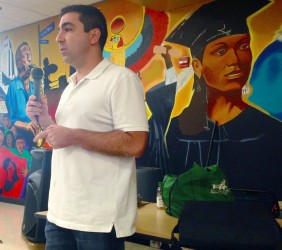
Attorney Edgar Khalatian said the REEF Project will support affordable housing. | Photo by Rachel Cohrs
The development also would add a pharmacy, retail space, a bank and open pedestrian spaces.
If the project is approved, it is projected to create 2,758 temporary construction jobs and 751 permanent part- and full-time positions, most of which would be in the hotel. Thirty percent of the construction and hotel jobs would be filled by people living within a five-mile radius. An apprenticeship program is being developed through Los Angeles Trade Technical College to provide training for local residents to qualify for the positions.
Out of dozens of resident questions submitted, a central question emerged: What’s in it for us? Residents at the meeting on Sept. 19 at Santee High School voiced concerns that the project wouldn’t cater to their needs.
“They are trying to make us feel like we are privileged that they are coming here, but they should be coming in on our terms and asking what we want it to look like,” said Adriana Cabrera, education representative for the Central-Alameda Neighborhood Council and co-founder of Empowering Youth in South Central.














